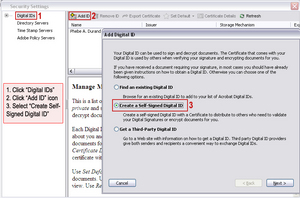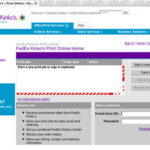One of the best things about the PDF file is that we can use it in so many ways. Upload it to be used online, add it to a CD or DVD to serve as a user’s manual, email it, print it, the list just goes on. With all that flexibility, though, comes some security issues. How many people does it take to view your file before someone decides to copy-paste the contents and call it their own?
Not many.
In this guide, you’ll learn how to sign and certify your PDF documents in a few painless steps. Signing and certifying adds additional security to your files – not just for your copyright protection, but for the end user who can see that what you intended to say hasn’t been altered along the way to them.
Creating a Digital ID
Before you’ll be able to sign or certify a PDF file, you’ll need a digital ID. You can purchase one from an Adobe partner, but it costs a fair chunk of change and isn’t necessary. It’s easy to create one yourself – and you can create as many as you need to use. For example, you can create one ID with your legal name and one ID with your business name.
To create your Digital ID, follow these steps:
1. Open Acrobat. Click on “Advanced” in your toolbar, and choose “Security Settings”.
2. From the left menu in the dialog that opens, click “Digital IDs”. If you currently have no IDs, the frame that opens will be blank.
3. Click the “Add ID” icon above the IDs frame (See Illustration 01). In the dialog that opens, select “Create a Self-Signed Digital ID”. Click Next … and Next again. In the screen that appears, you will want to add your details to each of the fields. Then, click Next again. You’ll have to give your digital ID a password (it can’t contain quotation marks or the characters ! @ # $ % ^ & * , | ; < > _), then click Finish to close the dialog and call your Digital ID created.
You can close the Security Settings window now.
Signing a PDF
Signing a PDF and certifying it are two different things. When you sign a document, you’re leaving it open to changes – very useful for workgroups and people collaborating on a project. You can’t specify the type of changes that a user can make, though, so if this is something you’re aiming for you’ll want to skip to the next section of this guide.
What you’re doing when you sign a document is basically state that you have approved changes to a document, and let the reader know that no additional changes have been made since you approved them. This will create a visible signature that appears on the PDF, but not when it’s printed unless the person printing specifies to have it included.
To sign your PDF, follow these steps:
1. Open the document you want to sign (it can be a ready-made PDF, a Word file, html, or any other file supported by Acrobat).
2. Click the “Sign” button in Acrobat’s toolbar, and choose “Sign this Document” from the drop-down menu that appears.
3. Since the document hasn’t been certified, Acrobat pops up a warning asking if you want to continue, or if you want to certify it. Remember that it’s harder to make changes to a document after it’s been certified – part of its security benefits – so for now, just click “Continue Signing.
4. Now Acrobat lets you know that you need a signature field to sign. Make sure that “Create a new signature field to sign” is selected, and click “Next”, then click “OK” to close the alert box.
5. To make the signature field, you will just drag a box out in the area you want your signature to appear. On the first page, close to your headline is best – you want it to be immediately visible when the document is opened.
6. When you let go of your mouse button – after dragging the box out – you’ll be asked which identity you want to use. Select the digital ID you want, and click “OK”. Then, you’ll have to enter your password.
7. Finally, choose the reason why you’re signing the document. There are several choices in the drop-down menu; just pick the one that’s most appropriate for this document.
Certifying a PDF
Before you decide it’s time to certify your document, make sure that you’ve made all the changes you’re likely to ever want to make. It is possible to edit a few things after you certify your PDF, but it’s difficult and limited to the security methods you’ve defined. Even though you have certified the document, Acrobat’s security methods are so good that you’re stuck with the same limitations as any other reader of the file.
By certifying your PDF, you specify what changes can be made to the file. Whenever approved changes are made, the certificate remains valid. If a reader tries to make changes you haven’t allowed, the certificate is invalidated and any subsequent users will be notified that the document was tampered with.
To certify your PDF, follow these steps:
1. Open the document you want to sign (it can be a ready-made PDF, a Word file, html, or any other file supported by Acrobat).
2. Click “File” in the toolbar, and choose “Save as Certified Document”. Click “OK” on the message box that appears to continue.
3. Click the drop-down box to choose which actions are allowed on your PDF. You can allow all changes to be made, Only Commenting & Form Fill-Ins, or No Changes. Leave the “Lock Certifying Signature” box checked – otherwise, someone can happily edit your signature and ruin your security. Click “Next” to continue.
4. The next screen will ask where you want the certification to appear. You can choose to have it shown on the document, which will place your signature in the PDF next to a little blue ribbon. Most people choose not to have it shown on the document, though. Click “Next” to continue.
5. Now you’ll choose which Digital ID you want to certify the document with. Pick your ID and click “OK”. You’ll have to enter your password to continue.
6. Finally, you’ll pick the most appropriate reason why you’re certifying the document. Then, click the “Sign and Save” button to complete the process. Acrobat will save your file to the same location it came from (so if you just created a PDF from a Word document, for example, it will save the PDF to the same spot your Word document is in).
At this point, you’ll want to close Acrobat and double-click your certified PDF to double-check everything and see how it looks. Don’t delete your original file until you’re happy with the certified version, just in case you want/need to make changes.
And with that, you’re secure and set!





